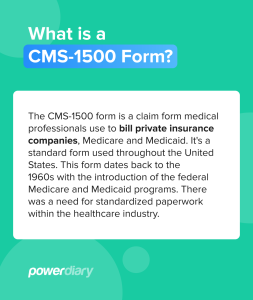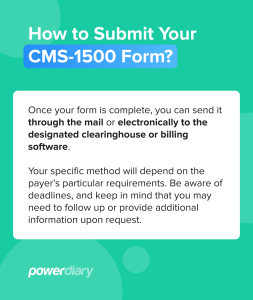The CMS-1500 form is a routine form used to bill Medicaid and Medicare (US) programs. Private health insurance companies also use this form to reimburse various procedures, supplies and services. Within a private practice setting, healthcare professionals submit CMS-1500 forms to demonstrate their services to the appropriate payer. Understanding and accurately completing CMS-1500 forms is essential for accurate billing, timely reimbursement and overall compliance.
What is a CMS-1500 Form?
The CMS-1500 form is a claim form medical professionals use to bill private insurance companies, Medicare (US) and Medicaid. It’s a standard form used throughout the United States. This form, dating back to the 1960s with the introduction of the federal Medicare and Medicaid programs, addressed a need for standardized paperwork within the healthcare industry
Today, the CMS-1500 form is used by numerous healthcare professionals, including doctors, physician assistants, physical therapists, speech-language pathologists, mental health therapists, hospitals, nursing facilities, laboratories, and hospice providers.
What is a CMS-1500 Form Used For?
CMS-1500 forms are used for billing and reimbursement. Healthcare providers complete these forms to outline the services they provide. This mitigates the risk of overbilling or underbilling. Insurance payers then use the information provided on these forms to reimburse such services.
CMS-1500 forms are also a critical part of patient care and treatment. Since they may be integrated into a patient’s medical record, they can support appropriate medical care and continuity of services.
How to Fill Out a CMS-1500 Form
If it’s your first time filling out a CMS-1500 form, go through each section slowly.
Sections 1-13: This is where you indicate the payer (Medicare, Medicaid, Tricare, Group Health Plan, etc.). From there, you will provide your patient’s essential information, including their address, date of birth, phone number, employer or school name, and insurance information. You’ll also indicate if there is another health benefit plan. In section 10, you’ll indicate if the patient’s condition is related to current or previous employment, an auto accident or another accident. In section 13, the insured or authorized person will sign their name.
Section 14: This is where you list the date of the patient’s current illness, injury or pregnancy.
Section 15: These sections also include dates about the patient’s specific treatment and condition.
Section 18-23: In these sections, you’ll include information about hospitalization dates, additional claim information, outside lab information, relevant charges, all the relative diagnoses (up to 12), resubmission codes, and prior authorization numbers.
Section 24-30: This is where you list the dates of service, place of service, procedures, services, or supplies, diagnosis pointers, relevant charges, your federal tax I.D number (you’ll choose between your social security number or EIN), patient account number, total charges, and the amount paid.
Section 31-33: This is where you sign your name, indicate any relevant degrees or credentials, and indicate your service facility location (i.e. your address). You’ll also provide the billing provider information and phone number.
Common Mistakes to Avoid
Even though the CMS-1500 form is fairly straightforward, it’s also easy to make mistakes. Incorrect coding can result in claim denials or payment delays. Ensure you use the appropriate codes to bill for your medical services. It’s a good idea to get in the habit of double-checking your forms before submitting them.
The form needs to be filled out entirely. Omitting information or overlooking a section can also result in delays or payment issues.
Although the CMS-1500 form is a standard paper claim form, it’s generally not advised to complete this document by hand. For example, in many cases, Medicare payment claims need to be electronically submitted. Furthermore, messy or unclear handwriting may not be processed correctly.
Finally, make sure that you have signatures in the right places. Handwritten signatures need to be legible, complete and dated. They also need to be signed by the appropriate individual, including the provider and the patient. Electronic submissions must adhere to standard criteria set by the payer.
How Many Diagnoses Can Be Reported on the CMS-1500?
Up to 12 diagnoses can be listed on a single claim form. However, to bill a CPT code, each medical provider must indicate which diagnosis the service was intended to treat. Therefore, at least one CPT code is required, and each form is limited to four CPT codes. If there are more than 4 diagnosis codes per billed CPT, you still need to narrow your options down to four. Choose the most relevant diagnoses you’re treating and rank them in order of severity.
Tips for Accuracy and Efficiency
The most important component of your CMS-1500 form is including accurate information. Make sure you use the appropriate services rendered and diagnoses. Always fill out each required field, and double-check that the total service charge matches the sum of each itemized charge. If submitting paper forms, use black ink to fill out the form and refrain from using any special characters.
It’s important to familiarize yourself with any payer-specific guidelines for CMS-1500 submission. In most cases, using electronic software is the best way to reduce the risk of making errors or delaying reimbursement.
How to Submit Your CMS-1500 Form
Once your form is complete, you can send it through the mail or electronically to the designated clearinghouse or billing software. Your specific method will depend on the payer’s particular requirements. Be aware of deadlines, and keep in mind that you may need to follow up or provide additional information upon request.
Complete CMS-1500 Forms Using Practice Management Software
As a busy healthcare professional, streamlining your paperwork can save you significant time when it comes to managing your practice. Rather than trying to figure it all out on your own, Power Diary includes everything you need for enhanced accuracy and compliance. We seamlessly integrate this documentation right within our EHR.
Conclusion
The CMS-1500 form is unquestionably an integral part of modern healthcare. Completing these forms accurately and promptly can help optimize your administrative workflow and ensure timely reimbursements. Leveraging technology allows you to streamline this process so you can focus on your main priority – excellent patient care.
Ready to start submitting electronic claims with Power Diary? Start a 14-day Free Trial now! No credit card required.







